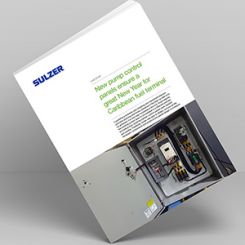Remote-operated submersible dredge units assist operations to search for undersea Alaskan riches
06/01/2016
With the price of gold hitting all-time highs a few years ago, the renewed gold fever is spreading across the globe. Miners and companies continue to feverishly search for the latest and greatest technology in hopes of striking riches. Even some of the largest TV networks such as the Discovery Channel are producing shows based on gold fever.
 Image 1. A Discovery Channel camera crew records video of the remote-operated submersible dredge used for gold mining in Alaska. (Images courtesy of Eddy Pump)
Image 1. A Discovery Channel camera crew records video of the remote-operated submersible dredge used for gold mining in Alaska. (Images courtesy of Eddy Pump)Mining for Gold
The key to gold mining is moving large amounts of material and separating the gold from the dirt. The process can be complex on land, but the difficulty increases greatly for underwater gold mining operations. The reward, though, can be huge payouts. One common method of underwater gold mining utilizes pumps to suck material to the surface and separate it through sluice boxes. Although somewhat effective, the method has drawbacks including restrictions on production because of lack of pump power and capabilities, lack of versatility, and environmental impact concerns. The lack of pump power and capabilities largely stems from the type of pumps used in gold mining. Most operations use centrifugal pumps deployed in an ejector-jet setup, which allows the pumping system to move large solids without clogging and destroying the pump. A conventional centrifugal pump has a small tolerance between the impeller and the volute, limiting what can pass through the pump without getting clogged at the impeller. Additionally, the constant bombardment of abrasive solids on the impeller affects the tolerances. As a result, the pump suction significantly decreases. In many operations, the equipment is pumping at a rate of about 5 to 10 percent solids versus water, and the heavier gold will often fall out of suspension because of lack of suction power. Another option does not involve a centrifugal, positive displacement or vortex design, but instead a hydrodynamic pump that utilizes fluid dynamics. This specific pump used in "Bering Sea Gold" has a geometrically designed spinning rotor within the volute that creates a perfectly synchronized eddy current that travels down the intake and naturally agitates the target material, drawing it into the suction. The eddy current, which is the same principle that results in the formation of tornadoes, can give the equipment the ability to pump a higher concentration of material versus liquid and the ability to move high-specific-gravity material such as gold. This equipment does not have an impeller and uses a rotor that does not have strict tolerances, decreasing clogging concerns. Compared with restrictions encountered by centrifugal pumps in gold mining applications, the pump used on "Bering Sea Gold" allows material to flow directly through the pump without needing an ejector setup. The result is the ability to pump material at solid rates of up to 80 percent while recovering the heavier gold. The higher solids content through these 4-inch pumps requires a sluice box normally rated for a 12-inch centrifugal pump. Without strict tolerances, the pump can operate for extended durations without maintenance.Underwater Options
Underwater gold mining is often seen as the most difficult and expensive method of mining because of the many limitations and lack of versatility in operating underwater. The three most-used methods are diver-suction, excavator or conventional suction dredges. Image 1. A Discovery Channel camera crew records video of the remote-operated submersible dredge used for gold mining in Alaska. (Images courtesy of Eddy Pump)
Image 1. A Discovery Channel camera crew records video of the remote-operated submersible dredge used for gold mining in Alaska. (Images courtesy of Eddy Pump)
